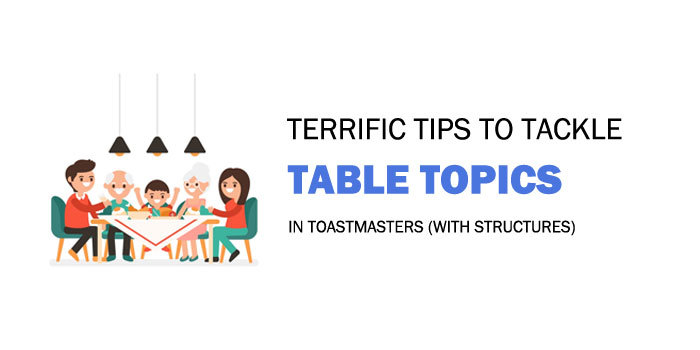Terrific Tips to Tackle Table Topics in Toastmasters (with Structures)
Ahh, table topics.
Do you feel scared whenever it’s time for table topics?
Do you hesitate to raise your hand when volunteers are called?
Does your mind go blank when you receive the topic?
We’ve all been there. The bane of every Toastmaster. Some jokingly call it Terror Topics.
We dread it, but we know the importance of table topics, or rather, impromptu speaking.
It is useful when it comes to job interviews, small talks or picking up girls being asked to do a last-minute talk at work.
And so, I decided to master this skill. I’ve attended workshops, watched countless Youtube videos and read public speaking books.
What I’ve learnt is that answering table topics is just like giving a regular speech. It has a structure. And once you understand what structure to use based on the question, you can answer the topic easily.
Here, I am sharing with you 8 structures you can use to tackle table topic questions, with example topics and answers for each structure.
8 Strategic Structures to Answer Table Topics
1. PREP (Point, Reason, Example, Point)
This is the most common method for answering a table topic. Most people do this unknowingly, as it is the most natural way of answering questions.

Point (“I agree that…”)
First, make your point.
You can agree or disagree with the topic.
You can answer the question directly.
Or you can state your position.
Reason (“…because…”)
Then, tell them why you made your point.
People without basic conversational skills will just answer a yes/no question with a yes/no answer.
They wouldn’t think to expand on their answers or give a reason.
And that’s how many conversations die.
Tell them the reason you agreed or disagreed with the topic.
Example (“…there was a time…”)
Then, share an example to back up your reasoning.
It could be a story, a personal anecdote or statistics and research.
It could even be a quote by an authority in that field.
This is where the meat of your answer is at and how you could speak “long enough” to hit the 1min mark. You could even share multiple examples if time permits.
The line between reason and example is blur. They could overlap or very well be the same thing.
Point (“That is why…”)
Finally, conclude by re-stating your point.
A simple line like “And friends, that is why I agree…”
To bring it to the next level, have a Call-to-Action (CTA) for your audience to take away with.
‘Point’ is also known as ‘Opinion’, hence the acronym OREO.
Example Topic: Life is 10% what happens to you and 90% how you react to it. Do you agree?
Point: Yes, I agree that life is not about what happens to you, but how you react to it.
Reason: I believe that adversity is the fuel of greatness.
We all have heard many stories of people born into poverty who later went on to become super successful in life.
Example: Oprah Winfrey grew up in an extremely poor and dangerous neighborhood.
Her parents divorced when she was young and she was sexually abused by men whom her family trusted.
With such a tragic childhood, there should be no reason why she would do well in life.
But she did. She got a scholarship, won a few beauty pageants, and later had one of the most successful talk shows in TV history.
She became one of the wealthiest women in America and among the highest paid entertainers in the world, and also made generous contributions to charities.
Oprah is only one of the multitudes of rags-to-riches stories which have proven over and over again that your circumstances don't define you.
Point: Hence, I agree that life is 10% of what happens to you, and 90% how you react to it.
CTA: So ladies and gentlemen, the next time you are met with hardship, use that as a fuel to propel you to greatness.
2. Pendulum Method
Like a pendulum, you swing to both sides of the argument. This is used when you can’t decide whether you agree or disagree with a question, or when you feel that both sides have merits.
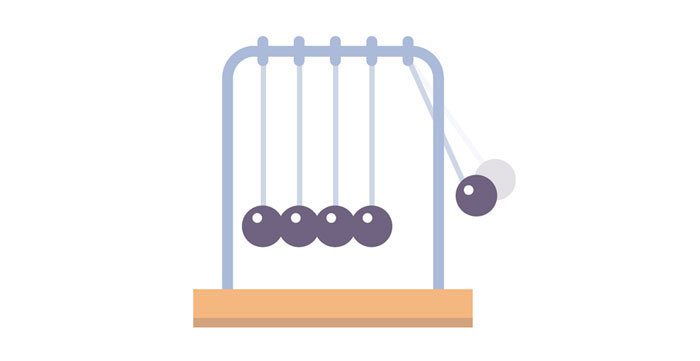
1. Start with One Side
First, you state one position.
“I agree that…” or “On one hand, I feel that…”
This brings you to one side of the argument.
2. Explain Your View
Just like the PREP method, when you state an opinion, you got to give a reason and some examples.
Note: You do not have to start by deciding you are using the pendulum method. The beginning of this method is similar to the PREP method. Perhaps during your speech, you thought of a second view, then you move to point 3.
Or you simply have too much time left.
3. Swing to the Other Side
However, instead of concluding, you explore the other option using this method.
“On the other hand, I feel that…”
4. Explain Second View
Again, back up this view with some stories or statistics.
Of course, you do not have as much time as the PREP method to do an in-depth explanation for both views. Mind your time.
5. Choose One Side
Finally, conclude with a stand.
Weigh your options and decide which side you agree with more.
“In conclusion, having weighed both sides of the argument, I agree with Position A more than Position B.”
Example Topic: Do you think it is important to have a New Year Resolution?
Start with one side: I do not believe in New Year’s resolutions, because studies have proven again and again that most people do not fulfill their new year’s resolutions.
Explain Your View: Look at the gym for example. It’s always packed in January but by February, it is almost empty. Most people that made a resolution to lose weight would have stopped going to the gym.
For that reason, I feel that New Year’s resolutions are a waste of time.
Swing to the Other Side: On the other hand, I feel that it is important for people to have a goal. It doesn’t have to be set on January 1st, it doesn’t have to be a SMART goal that is so widely preached, but it does have to be compelling enough to make people stick to it.
Explain Second View: A goal gives people a sense of direction, or something for them to work towards. Without a purpose or direction in life, humans act just like zombies - going through the motion of daily lives, without a sense of excitement.
Choose One Side: In conclusion, I don’t think it is important to have New Year’s resolutions, but I think it is important to have goals in life.
CTA: My friends, set a goal that excites you everyday and work towards it. Don’t wait till the first of January to do that.
3. The Balance
Very similar to the Pendulum Method, you explore both sides of the argument, but instead of choosing one side, you take the middle path. This is used when you feel that both sides do NOT have merits.

1. State Your Neutral Point
Whether you want to be politically correct or you simply have no strong opinion on the topic, state your neutral point and take the middle path.
Bonus: Shock everyone by announcing that you disagree with both sides of the argument. Do it confidently and somewhat defiantly.
2. Explain Both Views
Instead of exploring the merits of both sides of the argument, share why you DISAGREE with both sides of the arguments.
For this to work, you better have some strong arguments or emotional reasons why both sides don’t work for you.
3. State Neutral Point
Finally, conclude by re-stating your neutral point. If possible, offer an alternative and hope that you have just started a revolution.
Just kidding.
“Ladies and gentlemen, that is why I feel that both sides of the arguments will not work. Instead, we should all…”
Example Topic: Would you rather be religious or an atheist?
State Your Neutral Point: Ladies and gentlemen, I feel that we should neither be religious nor be an atheist.
Explain Both Views: With no offence intended, religion has been statistically one of the biggest reasons for war, terrorism and mass killings.
Furthermore, in recent years, crimes have been committed in the name of religions. Of course, not every religious person is a criminal - it is just a few rotten apples. I believe that the main teachings of any religion is to be a better person.
On the other hand, the common perception of an atheist is someone who does things without much consideration. Afterall, they don’t believe in the afterlife or karma, so why bother?
Atheists are perceived to be less likely to endorse values like commitment and love.
Research has shown that atheists are trusted less than religious people. Even atheists trust other atheists less than they trust religious people.
State Neutral Point: Therefore, I feel that no one way is better than the other.
Offer alternative: Instead, like an atheist, we should all embrace our differences and beliefs; and like a religious person, we should have faith, not specifically in God or Allah, but just, have faith. With faith guiding us, I believe that the world will be a more inclusive place for everyone.
(I admit, this is a rather extreme example and I mean no disrespect. It is just an example.)
4. Lightbulb Method (Problem/Solution)
Why lightbulb?
Remember those cartoon or comic characters getting a sudden brilliant idea and a lightbulb brightens up near their heads?
That’s when they have a solution to their problem.

1. State the Problem
Start your speech by talking about the problem that the topic represents.
Although unlikely, you may have some relevant statistics on the top of your mind; use them!
2. The Cause
How did the problem happen? Share it.
Many people would skip this step and go straight into the solution. How would you feel if a doctor just prescribed you a medicine without asking you questions to find the cause of your pain?
I feel that by sharing the cause, it shows your knowledge of the subject matter, boosts your credibility and segues nicely into the next point.
3. Offer the Solution
Like a doctor that has just diagnosed a patient, it is time to prescribe the medicine.
Give them the magic bullet, the holy grail, the answer to their problems.
Answer the topic, offer a solution, and urge the audience to do something. Give them a Call-to-Action!
Otherwise, what is the point of the solution if there is nothing the audience members can do?
Example Topic: The rich networks, the poor just works.
Problem: I’m sure we all have heard of the phrase “your net worth is your network”, yet why do most people still not do anything about their network?
Cause: I believe it comes down to what we have been taught since young. From schools to society, the only way to succeed in life, according to them, is to go to school, get good grades, land a good job, marry a good person and retire at 65.
Because of this constant reminder from the authorities in our lives, like our parents and teachers and bosses, we are afraid to leave this so-called “safe path” and venture into the wilderness.
Schools only teach us academics, they didn’t teach us communication skills and how to network the right way.
Perhaps you have tried attending a networking event, but because of this lack of skills, it didn’t turn out well and you stopped networking. So, you just focus on your work.
We are wired for stability and comfort and our jobs pay the bills. It isn’t your fault.
Solution: But it’s time to take back responsibility in your life. If you know you lack this skill, then go learn it. Take a course or find a mentor. Start small, perhaps by joining Toastmasters.
CTA: If you hate networking events, like I do, there are other ways to build up your network. Join a class or event to meet like-minded people. Most lasting relationships are built on a common ground like this.
Work on this skill bit by bit, and I’m sure your net worth will thank you for working on your network.
5. Timeline Method (Past, Present, Future)
Sometimes, a topic doesn’t require you to agree or disagree, nor does it require you to choose between two stands.
Or perhaps it does, but you have a different point of view at different stages of your life. Then this is a great structure to use.

Past
Firstly, share how you felt about the topic when you were a kid/a while back.
When you were younger, the world seemed so big, didn’t it?
Your worldview may not have been fully formed yet.
Be vulnerable and share your kiddish opinion back then. When something is personal, it usually is more universal. Someone in the audience would have felt the same in the past.
Present
Secondly, share how you feel about the topic right now.
As you grow older, you become wiser.
Has your opinion changed? Do you still feel the same way about the topic? Why or why not?
Share what you have been through to shape your current opinion. People like to hear about the journey of transformation.
Future
Finally, share your thoughts about the topic in the future.
Do you firmly believe that your opinion will remain the same?
Have you read something that gave you some foresight about the topic in the future?
Or are you unsure about what will happen in the future?
Even if you are unsure, share why you are unsure. You’d be surprised how many people will agree with the uncertainty.
Conclude
At this point, you’d have brought the audience on a journey with you – to the past, present and the future.
Finally, wrap up your speech by bringing the audience back to the present moment and share your message with them. Don’t forget to conclude.
The Timeline Method does not need to be your opinion on something at different stages of your life. It could be facts about someone or some place at different timelines.
For example, “Singapore in the 1950s was like a slump. Singapore now is an economic powerhouse. And who knows what Singapore will be like in the future?”
Example Topic: What is your greatest fear in life?
Past: When I was a little boy, my fears were very simple. Come to think about it, it is laughable what those fears were.
Cockroaches, boredom, the darkness. Those were common fears I had as a child. Life was so simple back then.
Present: As I grew older, the fears became a little more complex. Fear of rejection was a huge one.
I feared being rejected by the girl that I liked. I feared being rejected by the school of my choice. I feared not making the basketball team because I was not good enough.
When fears like these happened, it was painful. Even now, in the present moment, I still fear being rejected, but not as much as I used to. I guess after being rejected so many times, I became a little numb to it.
Future: What will I fear in the future?
No one can be certain for sure, but for the near future, I fear not leaving a legacy. I fear going through life without creating an impact in people’s lives. I fear being a cog in the machine, a wallflower, a 99 percenter.
Conclude: This fear made me find a purpose, wakes me up in the morning, and keeps me going. My friends, I do not know what your fears are, but if it is anything similar to mine, I urge you to find something that makes you feel fulfilled and do it every single day.
6. Zoom Method (Micro/Macro)
Imagine a pair of camera lens that can zoom in and zoom out on a subject. That is the inspiration for this method.
To put it another way, we can talk about a topic on a micro and macro level.

An example would be talking about a topic on a community, national, and international level.
Or a family, school, and government level.
You can go as big as the planet, solar system and the Universe level – if you know what you are talking about.
You can also go the other way and zoom into the smaller picture.
For instance, “When I’m with my family, I feel that…but when I’m with my spouse, I feel this way…and when I’m alone, I feel that the topic…”
The idea is to “take a step back” (or in) and see the bigger picture and not be boxed into one perspective.
Example topic: In helping others to succeed, we ensure our own success.
Home: I am an uncle of 3 beautiful kids. As much as I love them, they can get quite noisy and naughty at times. If you’re a parent, I’m sure you can relate. As someone who works from home, my productivity gets affected by their rowdiness.
As they are not my kids, I don’t use the cane on them. Instead, I sit them down and talk them through. I use these opportunities to teach them life lessons. It’s interesting how when you treat kids like adults, they behave like adults. They stop their nonsense, and I get my peace.
Organization: As a president of a Toastmasters club, my objective isn’t to clear as many speeches as I can. Rather, it is to create a learning environment that helps my members grow as much as they can.
I focused a lot on giving speech evaluations, both in my club and at other clubs. As a result, even though I am not giving speeches as much as I would like, by giving speech evaluations, I gained clarity on what makes up a great speech, and my own speaking skills leveled up as well.
Worldwide: I started this blog because I enjoy public speaking. I feel that I have so much to share, and hopefully through this blog, I am able to help as many people as I can. A blog can reach audiences worldwide. I feel fulfilled each time I publish a post.
They say: your income is proportional to the value you give to the world. And hopefully, one day, my income shows. Even if it does not, by writing these posts, I feel that I have the tools to be a better speaker.
CTA: Ladies and gentlemen, help others in whatever way you can, I assure you, you will receive much more in return.
7. Triangle Method
Speaking about perspectives, here’s a method where you can speak from three different perspectives.
Imagine a triangle. Each of the three points represents a point of view from three different sources.
For example, an Engineer, a politician and a child.
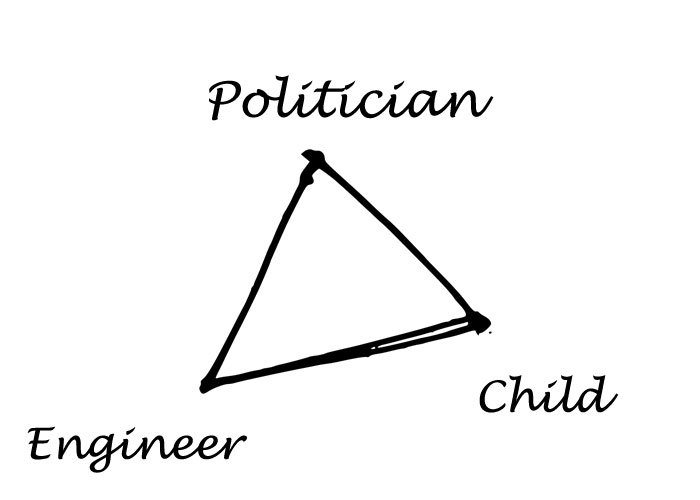
Put yourself into the shoes of each character and share how each character might feel about the topic.
This is particularly useful if the question has multiple characters or you are trained in different ways/take on different roles e.g. politician with an engineering background.
Example topic: Would you rather go on a long trip without luxury, or a quick but luxurious trip?
First perspective: As a long-time backpacker, I would rather go on a long trip without luxury. I have done it before and I believe that’s the best way to get to know a country and its people.
I would couchsurf or stay in cheap hostels, walk many miles to save a few dollars, do everything myself instead of going with an agency, all so that I can extend my trip.
Second perspective: As an entrepreneur, I believe that time is money. Instead of spending 20 hours on a bus, I could fly to my destination in a couple of hours.
Instead of fretting over how to get to an attraction, I could hire a guide and eliminate all hassles.
I feel that I deserve to pamper myself with luxury for working hard on my business. With the time saved, I would feel more refreshed and could get back to work faster.
Third perspective: As a travel blogger and content creator, I would choose a mixture of both.
Being on the ground and interacting with locals, discovering hidden gems and hole-in-the-wall eateries, and figuring out the budget alternatives are essential parts of capturing the best content and helping my audience.
Yet, I would also want to collaborate with hotels for sponsored stays and tour agencies for sponsored trips as a sustainable way of doing this long term, while enjoying the benefits of my work.
Conclusion: My friends, I guess it comes down to where you are in life, and what type of traveller you want to be. Whatever you choose, the most important thing is to enjoy your trip.
8. Storytelling Method
My favourite way of tackling table topics is to tell a story that demonstrates my point, has a message and ends with a Call-to-Action.
I always tell people that the best way to get a message across is to wrap it in a story.
There are so many benefits to telling a story: engaging the audience, holding on to their attention, bringing them on an emotional journey and allowing you to apply vocal techniques as well as using body language effectively.
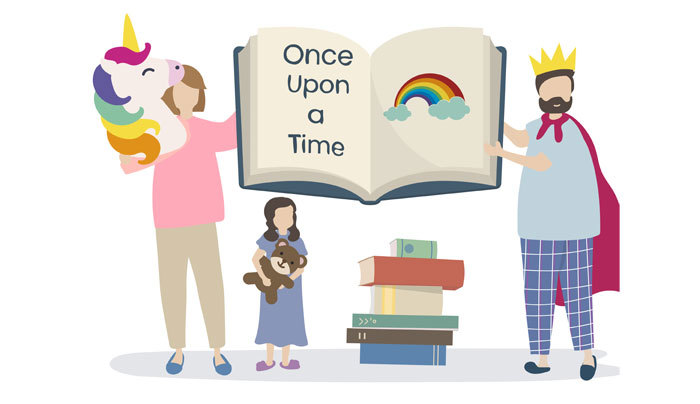
Instead of going through how to answer the topic step-by-step, here is what you can do to prepare for this technique.
Have a Story Bank
Sit down and think of any stories you might have with a message that you want to share. It could be a personal story, or it could be a short story that you heard from someone else.
Reading Aesop’s Fable is a great way to build up your story bank. It is literally a book of “morals of the story”.
Jot them down in your notes or a document. This will be your story bank.
It can be as simple as:
- story, message
- story, message
- story, message
Or if you’re like me, you can craft it out word for word and include a Call-to-Action for each story. It should be only 1 to 2 min long, so that you can improvise according to the topic you get.
A story can have multiple messages. For example, a story about your relationship with your father could be about family, love, commitment, blood is thicker than water, regrets, joy, childhood memories etc.
When you get the topic, quickly do a mental scan through your story bank and think of a suitable story. It doesn’t have to be 100% relevant - you can always improvise on the spot and link the story to the topic.
Example topic: “Success is nothing more than a few simple disciplines, practiced every day.” - Jim Rohn
Story: There was once a stonecutter who was going to cut this huge rock on his farm. He lifted up his axe, swung it over his head, and bam, hit the rock.
Guess what happened? Nothing. Not a single crack, not a single bit of stone came out of the rock.
He lifted up his axe again and went for a second swing. Same thing. Nothing happened.
Then a third swing, and a 4th swing.
The stonecutter was unfazed. Because he knows that even though on the surface, it seems like nothing is happening, he knew deep down in the foundation of the rock, something is changing.
And so, he kept swinging his axe. 98, 99 and on the 100th swing, bam! The rock split into two clean pieces. His job was successful.
My friends, Are you doing something in your life where it seems like no matter how hard you keep doing, nothing seems to be changing?
Perhaps you are learning a new skill. Or you are not getting better at your job. Maybe it’s even in Toastmasters.
My personal experience: I joined a gym for the past few months and nothing seems to be changing in my physique. Initially, I felt discouraged.
But I know that as long as I do my workouts, watch my diet and trust the process, my body will soon show some changes. In fact, I’ve gotten stronger, my stamina has improved, my resilience and discipline is stronger too.
Message and CTA: My friends, I urge you to trust the process, and remember the story of the stonecutter. Because as long as you keep getting better a little bit everyday, something in your foundation will change, and just like the stonecutter, you will hit your goal. Keep going.
The same story can be told for a topic about discipline, resilience, perseverance, mini-improvements, success, never giving up, greatest lesson learnt etc.
I used this story for a topic on “You do not have to be great to start, you have to start to be great.” It isn’t 100% relevant, but I managed to link the story to the topic by adding a few sentences.
I hope you enjoyed these 8 structures and learnt something about tackling table topics. It can be overwhelming when you’re just getting started.
My suggestion is to just pick one structure and focus on it for a few weeks, then move on to the second structure.
If you noticed, the structures are overlapping.
For instance, you may be starting with the PREP structure, then you thought of another side of the argument, which brings you to the Pendulum structure, and to support your arguments, you use the Storytelling method.
Or perhaps you are using the Timeline method and all 3 perspectives happen to be 3 points of the Triangle method, which covers both sides of the arguments in the Pendulum method, and again, you back up your examples with the Storytelling method.
Bonus Table Topic Tips
Pause
When you get the topic, don’t start talking immediately. Take some time to think of the right structure to use, and scan through your story bank.
It’s better to spend 10s to organize your thoughts, than to start right away and mess it up.
The time only starts when you start.
Get to the Point
You have very limited time, so don’t waste it by greeting everyone and introducing yourself.
That’s what the introduction at the start of the meeting is for.
Start your speech strong.

To Repeat or Not?
There are different schools of thought when it comes to repeating the topic.
Personally, I don’t think that it is necessary to repeat the topic, immediately after the table topic master just read the topic.
Some people say to repeat the topic to buy time, but that brings us back to tip number 1, and that is to pause before you speak. There is no need to ‘buy time’.
Remember, time is precious. You only have 2min30s.
However, if you are the type that thinks better as you speak, then go ahead.
Answer the Question
It is common to see Toastmasters speak so passionately that they go off topic.
Please remember to bring your speech back to the topic.
When I use the Storytelling method, I don’t answer the question at the start. Only after my story and sharing the message, I link it back to the topic and answer it directly.
Call-to-Action
Always, always, always have a Call-to-Action.

Having a message is great, but telling the audience what to do makes them feel like they have learnt something that they can apply in their lives.
All great speeches have a Call-to-Action. Look at all the above examples, they always end with a Call-to-Action. (Hint: use a verb)
Delivery
Do not forget your standard speech delivery techniques, like using body language and vocal variety.
Somehow it seems like most people forget about these speech techniques when it comes to table topics.
If you take a look at the table topics contest judging ballots, you’d notice there are sections titled ‘Physical’ and ‘Voice’.
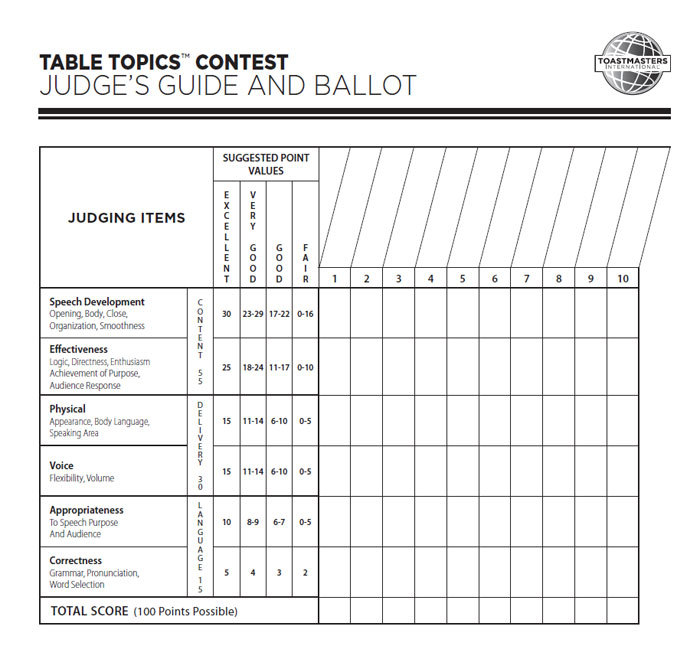
It is a speech! So use all elements of a good speech.
Practice Everyday
What?! Everyday?
Yes, practice table topics everyday. Think about it: it only takes you 1 to 2 min each day.
That’s not a lot of time.
Google ‘table topics questions’ and there are hundreds of them available in an instant. Go through them one by one and see if you can apply any of these structures.
Do it everyday. Or twice a day - even better.
I have created a service which sends you a topic a day to your inbox. All you gotta do is open the email, answer the topic, and bam, you're done practicing for the day.
Conclusion: Definitive Table Topics Guide
I hope that all these tips and structures help you in your journey to conquer your fear of table topics and impromptu speaking.
After knowing these structures and having a story bank, I no longer feel afraid to raise my hand during table topics session.
In fact, I can’t wait to attempt the questions!
Don’t feel a sense of regret because you didn’t try. Don’t go home after a meeting and think to yourself “I should have raised my hand! I could’ve answered that question!”
I know that feeling and I no longer want to feel that way any more.
Use these structures and tips, and let me know what you think in the comments below.
(See the CTA there?)
